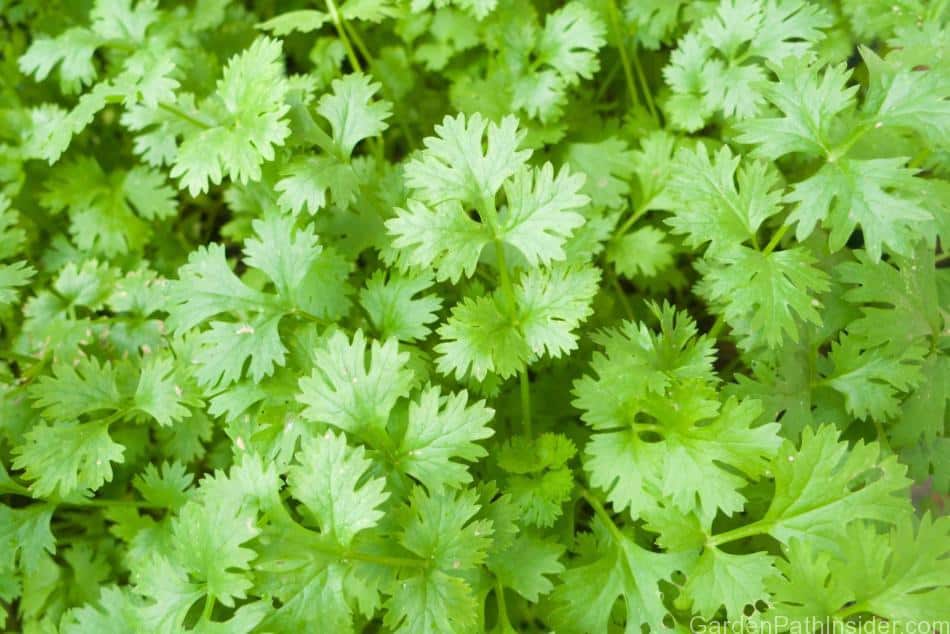
Fresh basil and cilantro are fragrant flavorful herbs that are easy to grow and enjoyed in many culinary dishes. As companion plants, basil and cilantro are great to grow side by side in your herb garden.
Basil and cilantro can be planted together in the same growing container or garden bed; as both require moist fertile soil and full sun. Basil and cilantro are great companion plants to grow, as cilantros’ volatile oils may repel pests like aphids and beetles that would damage tender basil leaves.
Growing basil and cilantro together is a great introduction to companion gardening. You can enjoy these fresh herbs in your kitchen year-round with the right materials and growing conditions!
Basil and Cilantro Companion Planting
Basil and cilantro are companion plants and can thrive when grown side by side. Cilantro contains strongly scented oils called volatile oils that act as a strong deterrent for several small insect pests like aphids and moths.
Volatile oils are essential oils that evaporate at normal temperatures defusing their fragrance when the leaves tussle or the branches break.
Basil and cilantro also require similar growing conditions for soil nutrients, light needs, and water needs; making both easy to care for together. We will cover these growing conditions below.
Both basil and cilantro can be planted together in the same growing container, or garden bed. During the intense summer heat, both plants may need to be watered several times per day in hot weather.
Basil grows in clusters that can slowly spread through its growing space over the course of a growing season. Cilantro grows in clusters of tall stalks that may drop seeds during the season, sprouting new growth around the parent cluster.
If you are planting basil and cilantro in the same growing space, it is best to plant about 8 inches apart (20.32 cm). This will give each plant’s roots enough space to spread and develop during the growing season, without choking the other plant out.
Related article: Can Basil and Rosemary Be Planted Together?
Are you planting a kitchen herb garden? See our article resource on growing rosemary as a companion plant to basil. Rosemary is a wonderful herb that can be added to savory dishes like, chicken, pasta, and even topped on pizza.
Read more here: Can Basil and Rosemary Be Planted Together?
Cover image details: Coriander growing in the garden © natara/123rf.com
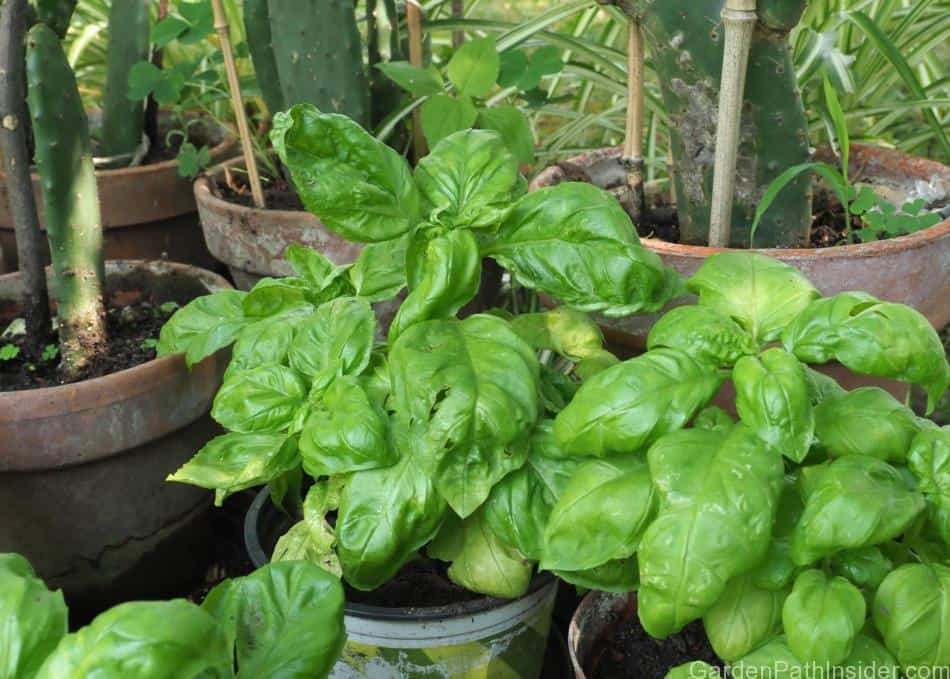
Basil Varieties
Basil is an annual plant with large tender leaves that have a sweet refreshing flavor. Basil is used in many dishes, from pizza and salads to savory pasta.
Basil grows about 36 inches tall (91cm) and blooms small flowers during the spring and summer.
Basil requires warm day-time temperatures around 60°F to 70°F (15°C to 21°C), and night-time temperatures that stay above 45°F to 50°F (7°C to 10°C).
Basil is not a hardy plant and will not survive a frost or extended cold temperatures. Basil spread slightly as it grows, though this plant will not take over garden beds with the same ferocity as mint.
There are several species of basil, each with different flavors, fragrances, and textures. It is recommended to grow a single species of basil per pot or garden plot, as growing several varieties of basil together in close proximity may cause cross-pollination. The cross-pollination will cause the species to blend together, and the individual varieties will lose their unique flavors.
Below are some of our favorite Basil species to use in the kitchen:
- Sweet basil (Ocimum basilicum)
- Cinnamon basil (Ocimum basilicum Cinnamon)
- Lemon basil (Ocimum x africanum)
Sweet basil has a refreshing taste and is often paired with mozzarella cheese, tomatoes, and a balsamic vinaigrette on pizzas or focaccia bread. Our container garden often includes at least one variety of tomatoes in addition to our sweet basil.
If you are interested in expanding your container garden and would like to enjoy fresh produce year-round, read our article resource on growing tomatoes indoors year-round. In the article, we describe the path to a successful and fruitful indoor tomato garden.
Read more here: Can You Grow Tomatoes Indoors Year-Round?
Cilantro Varieties
Cilantro is an annual that can withstand cold harsh winters and return each season. There are many varieties of cilantro though the most popular by far is the leaf cilantro, which has tender leaves and is heavily used in Mexican cooking.
Other varieties like Long-Standing and Vietnamese Cilantro grow best in hot tropical climates and are known to be more flavorful than the traditional leaf cilantro.
Cilantro’s unique fragrance and flavor are a wonderful addition to savory meals and treats, like soups, salads, tacos, and chutney.
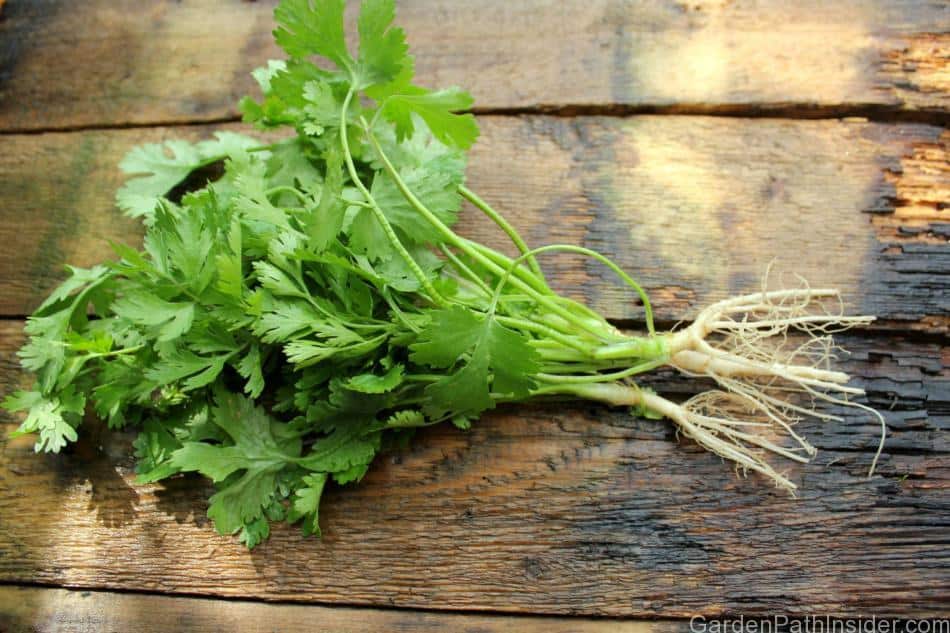
Growing Requirements for Basil and Cilantro
Basil and cilantro will thrive in shared growing containers or garden beds. A single basil plant can spread quickly in any growing space it’s planted in. A single cilantro plant will grow into a tall willowy cluster if not trimmed or pruned during the season.
Basil: Container and Garden Bed Requirements
Basil is easy to care for, as it can be easily grown in container gardens or garden beds. A single store-bought basil plant will spread and provide multiple harvests during the season. Basil does not need to be grown in a large container or pot to thrive.
Basil does best in smaller containers that have less soil, as too much soil can hold excess water and drown the roots. A single basil plant will grow best in a pot that is 6 to 8 inches in diameter (15cm to 20cm), and 6 to 8 inches deep (15cm to 20cm).
Cilantro: Container and Garden Bed Requirements
Cilantro can thrive in any size container. The cilantro plant will grow to a height of over 15 inches (38 cm) if not cut back during the season. Though multiple harvests will stimulate new growth, the taller the plant gets the less flavor the leaves have before the cilantro begins to drop its seeds.
Adequate drainage of the container is critical for success. Clay pots usually have a large drainage hole in the bottom of the pot. Plastic containers may lack adequate drainage ports, though you can always add your own holes to the bottom of the container with a hand drill.
Once you have holes in the bottom of your pots, add a few bits of broken clay pots or small rocks to keep the soil or roots from blocking the drainage ports. Adding a clay dish under the pot will contain any excess water.
If the plants are in small pots, you can bring your plant to the sink and water it letting the excess water drain in the sink.
Soil Needs for Basil and Cilantro
Basil and cilantro both thrive in well-draining fertile soil. The soil should be loose enough to allow the small roots to easily spread and develop. Avoid using soil from your yard, as it is too dense and compact for potted plants.
If you have compost available, you can mix one-part compost with one-part topsoil for a great fertile growing medium for both plants. Store-bought soil works great for indoor gardens or container gardens.
If you are planting in a container or pot, use a sterile potting mix as backyard topsoil may contain bacteria or insects that could damage or contaminate your indoor container garden.
Basil and cilantro grown outside in a garden bed can be planted in well-draining topsoil. For outdoor plants, I fertilize once a season with an organic fertilizer. Always follow the directions on fertilizers, as this step can negatively affect the garden if too much is used.
Water Needs for Basil and Cilantro
Basil and cilantro require damp, slightly moist soil to thrive. Water daily as needed in normal weather, and water twice a day in the extreme summer heat. Basil is sensitive to drought, and the leaves will begin to shrivel as soon as the plant starts to get dehydrated.
Always test the soil moisture before watering your plants. To test the soil moister, press your finger in the soil a few inches away from the root system. Be careful not to press too deep, damaging the roots. Water when the soil feels like it is slightly dry to the touch. Too much water sitting in the roots can cause the roots to rot and the plants will die.
Pro Tip: Before you harvest basil make sure the plant has been watered thoroughly. Leaves on a well-watered basil plant will be plump, crisp, and tender; while leaves in a thirsty basil plant will be wilted, soft, and stringy.
Signs of dehydration in basil and cilantro. When basil and cilantro need water, the tops on the branches will start drooping over sideways and the soil will begin to pull away from the sides of the pot. Additionally in basil, the leaves will start to look very dry and brittle. When you see these signs, it is time to water your plants.
Watering potted basil and cilantro. When watering potted basil and cilantro, you can bring the plant to a sink and water the pot thoroughly until water begins to drain from the bottom of the pot. Leave the pot in the sink overnight until the water has fully drained, then return to its sunny growing space.
Watering in-ground basil and cilantro. Basil and cilantro planted inground, are still susceptible to overwatering if the garden bed does not drain excess water well. To see if your plant needs water check if the branches are drooping over or the leaves are shriveled. Overwatering can also cause the plants to become droopy, as the plants slowly drown in standing water around the roots.
If you have a backyard garden it may be worthwhile to invest in a soil moister sensing meter or a T-handle soil sampler probe. Both tools will give you an accurate reading of your garden’s moisture levels and could save you from overwatering some of the more fragile plants in the garden.
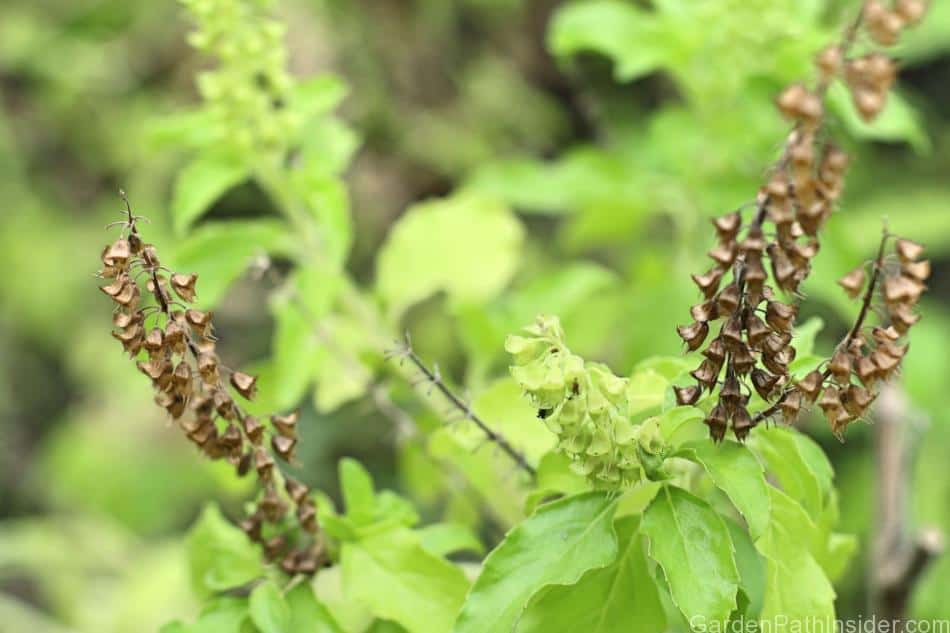
Light Needs for Basil and Cilantro
Basil and cilantro both require full sun of 6 to 8 hours per day to fully thrive, though both plants will grow with less than full sun. Maximum plant growth will require full sun.
In warmer climates, plant basil in a growing space that gets sun in the first part of the day with shade in the afternoon when temperatures peak.
Basil and cilantro grown indoors should be placed by a natural light source that will get the full day’s sun. Avoid placing your container garden near heating elements like space heaters, ovens, or heating vents.
Basil is a perennial and will die off during the cold months of the season. In warmer climates, basil may return the following season if the winter was not extremely harsh.
Cilantro grows as a tall bushy clump and will slow its growth, bloom, and go to seed in the cold months of warmer climates. Cilantro will also go to seed and bloom in the cold months if it is grown indoors.
Without full sun and adequate heat, cilantro will maintain its current size through the dormant period. Cilantro grown outside will drop its seeds at the end of the season and sprout in the same spot the following season.
When Can You Harvest Basil and Cilantro?
Harvest Basil
Basil leaves are best harvested once the plant has established its root system. Some varieties of basil can grow several feet tall, though most stay well below that.
To increase the number of leaves each basil plant grows, you can pinch off the new growth at the top of the plant once the plant reaches 8 to 12 inches (20cm to 30cm). Nipping the new growth at the top of the plant will cause the plant to grow bushy with more branches and leaves.
Pro tip: when harvesting leaves from basil and cilantro use a pair of scissors to snip the leaves off as close to the stem as possible. This will avoid tearing or damaging the branch of the fragile plants during harvest.
Harvest Cilantro
Cilantro can be harvested at any time once the plant has established its roots. Only harvest 25% to 30% of the plant in any single harvest. This will allow the plant to survive and regrow for another harvest.
To harvest cilantro, use a sharp pair of scissors to cut a small cluster of cilantro off as close to the dirt level as possible.
Once cilantro is established it is recommended to trim the plant throughout the growing season to encourage new growth and to postpone the plant going to seed. When the plant begins to bloom, also called going to seed, the flavors of the leaves will begin to change.
If you live in a warm climate the cilantro will survive through the winter with little effort needed to winterize the plant.
Below is a quick view summary of both basil and cilantro needs for your reference.
| Plant | Soil type | Water needs | Light needs | Bloom time | Harvest time |
| Basil | Loose well-draining fertile soil | Keep the soil slightly damp to moist. Water as needed. | Full sun | Summer | Basil leaves are edible at any time, though its best to wait until plants gets at least 6 inches tall (15cm). |
| Cilantro | well-draining fertile soil | Keep the soil slightly damp to moist. Water as needed. | Full sun | Spring, Summer, Fall | Cilantro leaves are edible at any time. |
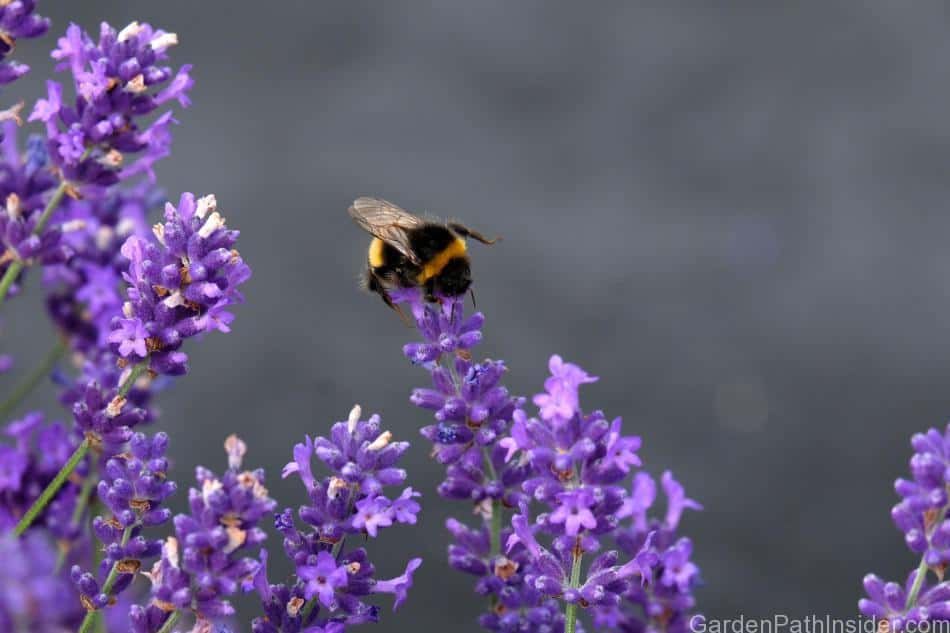
Looking to expand your herb garden but you’re running out of space? We have a solution for you. Growing lavender in hanging baskets is a great way to introduce the fragrant herb into a garden of any size.
Our resource article will guide you on the best ways to incorporate and maintain hanging lavender into your garden. Read more here: Can You Grow Lavender in Hanging Baskets?
